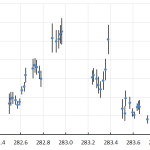A summary of the activity of the CAMS BeNeLux network during the month February 2019 is presented. This month offered many clear nights, 8 nights with more than 200 orbits, 2 nights had over 300 orbits. In total 17784 meteors were recorded, 10570 of which proved multiple station, or 59%. In total 3485 orbits were collected during this month, 20% less than in February 2018.
1 Introduction
December 2018 and January 2019 brought mainly unfavorable nights, worse than what these winter months normally could offer. The first half of February 2019 brought reasonable circumstances while the second half of February counted exceptional many clear nights. This way we can compare two exceptional good months of February in two consecutive years.
2 February 2019 statistics
The weather followed a similar pattern as previous year, with a series of clear nights after a long period of rather unfavorable weather. 8 nights resulted in more than 200 orbits (against 11 nights in 2018), 2 nights of these had over 300 orbits. Overall the weather was slightly less favorable than previous year, but still far better than what one may expect for this winter month.
Table 1 – February 2019 compared to previous months of February.
| Year | Nights | Orbits | Stations | Max. Cams | Min. Cams | Mean Cams |
| 2013 | 9 | 38 | 6 | 5 | 2.3 | |
| 2014 | 21 | 601 | 12 | 29 | 20.3 | |
| 2015 | 21 | 777 | 14 | 39 | 27.4 | |
| 2016 | 24 | 1075 | 17 | 51 | 13 | 36.9 |
| 2017 | 16 | 717 | 18 | 53 | 20 | 38.6 |
| 2018 | 26 | 4147 | 22 | 91 | 48 | 81.7 |
| 2019 | 24 | 3485 | 18 | 74 | 50 | 68.8 |
| Total | 141 | 10840 |
CAMS BeNeLux managed to collect 17784 meteors (23439 in 2018) with 74 cameras (91 in 2018) capturing at 18 participating stations (22 in 2018) during the best nights. 10570 or 59% of these meteors were multi-station meteors, good for 3485 orbits (4147 in 2018). With the 2019 results the total number of orbits for February obtained by CAMS BeNeLux got at 10840 orbits collected in 141 successful nights. The statistics for February 2019 are compared in Table 1 with all previous February months since the start of the CAMS BeNeLux network. Although the weather was comparable with previous year, less results were obtained due to a significant lower number of operational cameras.

Figure 1 – Comparing February 2019 to previous months of February in the CAMS BeNeLux history. The blue bars represent the number of orbits, the red bars the maximum number of cameras running in a single night and the yellow bars the average number of cameras running per night.
On average 68.8 of the available 74 cameras were capturing per night (81.7 of 91 in 2018). This high average corresponds to 93% of the maximum number of cameras available. Especially in the first years, before AutoCams was available in the BeNeLux, many cameras remained switched off when the weather did not look good in the evening. This way the chances to obtain double station meteors for those cameras that remained active were rather small. 4 nights did not yield any orbit and only one night remained without a single meteor recording. AutoCAMS kept a minimum of 50 cameras active on all nights, even on completely overcast nights. On as many as 24 nights orbits have been collected. Figure 1 shows the decline in camera capacity compared to 2018. This combined with exceptional good weather resulted in a nice total number of orbits for this winter month.
On 2018 February 14, the CAMS BeNeLux network recorded a few similar orbits which were identified with a new minor shower listed as the February Hydrids (FHY-1032) in the IAU working list of meteor showers (Jenniskens et al., 2018), (Roggemans and Cambell-Burns, 2018). Not any single orbit of this shower was detected in 2019.
3 Conclusion
The exceptional favorable weather in the second half of February 2019 resulted in another successful month of February for a second year in a row.
Acknowledgment
Many thanks to all participants in the CAMS BeNeLux network for their dedicated efforts. The data on which this report is based has been taken from the CAMS website (http://cams.seti.org/FDL/index-BeNeLux.html). The CAMS BeNeLux team is operated by the following volunteers:
Hans Betlem (Leiden, CAMS 371, 372 and 373), Jean-Marie Biets (Wilderen, CAMS 380, 381 and 382), Martin Breukers (Hengelo, CAMS 320, 321, 322, 323, 324, 325, 326 and 327), Bart Dessoy (Zoersel, CAMS 397, 398, 804, 805 and 806), Jean-Paul Dumoulin and Christian Walin (Grapfontaine; CAMS 814 and 815), Luc Gobin (Mechelen, CAMS 390, 391, 807 and 808), Robert Haas (Alphen aan de Rijn, CAMS 3360, 3361, 3362, 3363, 3364, 3365, 3366 and 3367), Robert Haas (Texel, CAMS 810, 811, 812 and 813), Robert Haas / Edwin van Dijk (Burlage, CAMS 801, 802, 821 and 822), Klaas Jobse (Oostkapelle, CAMS 330, 331, 332, 333, 334, 337, 338 and 339) , Carl Johannink (Gronau, CAMS 311, 312, 313, 314, 315, 316, 317 and 318), Hervé Lamy (Dourbes, CAMS 395), Hervé Lamy (Humain, CAMS 816), Hervé Lamy (Ukkel, CAMS 393),Koen Miskotte (Ermelo, CAMS 351, 352, 353 and 354), Steve Rau (Zillebeke, CAMS 3850 and 3852), Paul Roggemans (Mechelen, CAMS 383, 384, 388, 389, 399 and 809), Hans Schremmer (Niederkruechten, CAMS 803) and Erwin van Ballegoij (CAMS 347 and 348).


